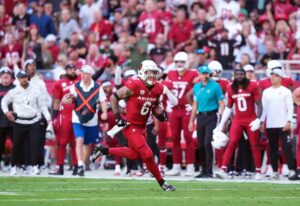There’s a number, typically between four and six, that can drastically change a draft prospect’s stock. Players can have incredible film but slip down boards simply because of this one overanalyzed number. On the other side of this, they can have subpar film but skyrocket because of this same number. What number is this? The 40-yard dash time.
The 40-Yard Dash: Most Overanalyzed Part of the Draft Process
What exactly is the 40-yard dash? Put simply, it’s become the benchmark NFL teams use to gauge the speed of a prospect. There are sometimes questions as to how heavily it should truly be weighed. The 40-yard dash measures straight-line track speed, and in the NFL players almost never just run in a straight line down the field. Receivers and corners are the only players who typically run in straight lines down the field (excluding special teams) and this isn’t a frequent occurrence.
The basic NFL route tree consists of nine routes, one of which is called the fly, go, or nine route. This is a route run straight down the field and it’s purpose is for a receiver to outrun his defended downfield, but it’s also among the least frequent routes used. It’s highly risky for quarterbacks to toss long bombs to receivers streaking down the field as far and as fast as possible. Much more typical are routes going 15 or less yards downfield, as these routes minimize risk and maximize an offense’s chances for success. A quarterback is far less likely to be intercepted throwing to an out route or a screen than he is tossing a long bomb to a go route, so offensive coordinators usually opt for the safer choice.
Speed certainly is one of the most important attributes for a football player, but there’s a difference between straight-line track speed and playing speed. Playing speed in the NFL is more about how close a player can stay to his top speed while going in and out of breaks, cuts, and changes in direction. Typically plays also occur within 15 yards of the line of scrimmage so short range speed is also extremely important. How fast a player can run 40 yards on a perfect track will not accurately display his on-field speed.
The Case of Teez Tabor
Towards the beginning of draft season, Florida’s Teez Tabor was talked about as a potential top ten pick. His film shows an incredibly gifted corner with good playing speed who very rarely got burned. In fact, Tabor allowed only four catches over 20 yards all season. His speed was never questioned and never deemed an issue on the field. Until his 40-yard dash, that is.
After running a 4.63 at the combine and a 4.77 at his pro day (both with a hamstring injury) everybody began questioning his speed and if Tabor could even find success in the NFL despite the incredible skill his tape displayed. Though he almost never had trouble keeping up with his man and was one of the least burned corners in college football, these 40 yard dash times are completely changing some people’s opinions of him. Tabor has went from being regarded as a likely top 15 pick to speculation of him dropping to the second or even third round. Did his film or level of play change? Not a bit. He’s still the exact same player, but this incredibly overanalyzed test number will cause some teams to pass on him.
The Final Five Yards
To conclude this discussion, we’ll go over the points made one last time. First, though the 40 is a somewhat effective gauge of speed, it is incredibly overanalyzed. Straight-line track speed and playing speed aren’t the same. The three cone drill may be a more effective test considering how much more important change of direction speed is. It’s rare that a player ever sprints 40 yards straight down the field. Secondly, if a prospect has impressive on-field play, he should not be discredited due to a slow 40-yard dash. Some guys are great at track style running, while others are better running on a football field. If a player consistently demonstrated adequate playing speed, a 40-yard dash shouldn’t change how his speed is viewed. Should the 40-yard dash be eliminated? No, but it’s implications on prospect evaluation have got to decrease. Film doesn’t lie.
Main Photo:






